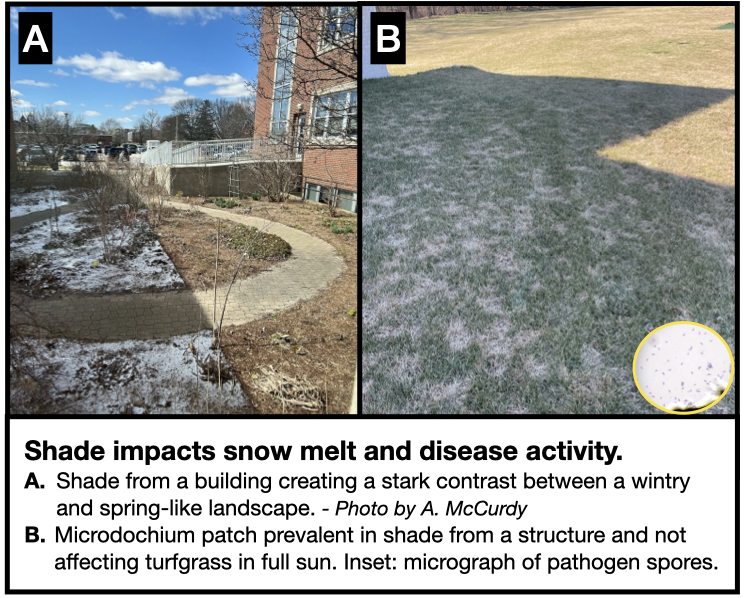Pink snow mold is a disease caused by the fungal pathogen Microdochium nivale (syn. Monographella nivalis) that is being observed in middle and northern Indiana this late winter. The pathogen is termed psychrophilic, or cold loving, due to its propensity to grow and infect in colder temperatures. The disease can be particularly severe on unfrozen turf under an insulating snow cover, but the pathogen doesn’t necessarily need snow to form and cause damage. For this reason, the disease is also referred to (perhaps more correctly) as Microdochium patch by researchers, since symptoms also occur in the cool, wet conditions that have been the norm this winter. Conversely, the true snow molds, such as gray and speckled, require an extended amount of snow cover to develop, and are more regularly observed in the colder climates of Michigan, Wisconsin, Minnesota and Canada.

Microdochium patch can occur on nearly all turfgrass species, with the most severe symptoms occurring on creeping bentgrass and annual bluegrass. On higher cut lawns such as Kentucky bluegrass or the fescues, Microdochium patch is less common, but when it occurs can be very conspicuous. Symptoms on higher cut turfgrass are circular tan brown to white patches approximately a foot or more in diameter that can coalesce to affect larger areas. When the disease is active, especially on cool wet mornings, a faint pink hue may be observed on patch edges. This pink coloration is the sporodochia which bear numerous spores, or conidia, that facilitate transmission and disease spread. Microdochium patch symptoms can be easily confused with red thread, necrotic ring spot, or Ascochyta blight, which may occur later in the spring season.
As shown above, shade greatly enhances disease incidence and severity. Note photo A and how the sunlit side has daffodil bulbs emerging from their slumber, while the shade from the building on the other half maintains a wintry wonderland. The extension of cool, wet conditions from the shade in photo B provides the conducive conditions for Microdochium patch while the sun-dried canopy remains disease free.
Heavily shaded areas under a tree canopy can be reduced through selective pruning, but renovating a multi-story down to a ranch isn’t quite as feasible. In reality, most cultural practices for Microdochium patch suppression need to be remembered and implemented next fall. Don’t apply nitrogen fertilizer too late in the fall, particularly during extended periods of cool, wet weather. Continue mowing in the fall at a normal mowing height until the turf stops growing to prevent excessive growth and lodging. Don’t reduce mowing height or scalp the turfgrass which may lead to winter injury.
When used on high amenity areas such as golf course or sports fields, one or two fall preventive fungicide applications prior to the first snowfall may be necessary to prevent widespread damage. If cared for properly, higher cut turfgrass will usually recover from Microdochium patch, so fungicide applications are normally not recommended in the home landscape. Restrict mowing and traffic while the disease is active. In affected areas, rake the matted leaf tissue to allow for sunlight and air into the turfgrass canopy. When high temperatures in spring rise consistently into the 60-70°F range, apply a quick release nitrogen fertilizer to encourage recovery. If the disease is especially severe, consider overseeding the area in early spring to rebuild lawn density.